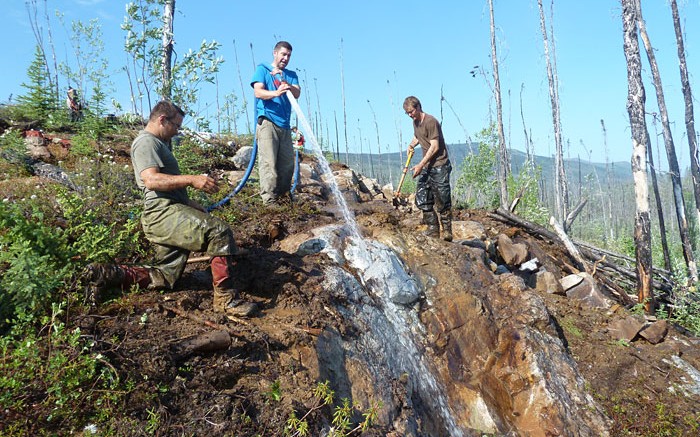VANCOUVER — After just 10 weeks of exploration at the Plateau South project, it is starting to look like Goldstrike Resources (TSXV: GSR; US-OTC: APRAF) made a good choice when it dropped 23 other Yukon gold properties to focus on its eight best projects, with Plateau South returning high-grade gold intercepts in a first-pass drill program.
Plateau South is a 30 km long property that lies south of the Hess River, some 300 km east of Dawson in central Yukon. Goldstrike signed a deal for the ground in 2011 based on the Yukon government’s silt-sampling data and favourable geology. Plateau South was not the only Yukon ground that Goldstrike liked — in mid-2011 the company acquired no fewer than 31 Yukon properties.
After the 2012 field season, however, Goldstrike terminated its interests in 23 of its projects, retaining only eight promising ones.
In fact, the company did more than keep its Plateau-area lands — it expanded its holdings in the area tenfold, to almost 400 sq. km. Those lands are now divided into three projects: Plateau South, Plateau North and Plateau Northeast.
At Plateau South, Goldstrike’s prospecting, sampling and mapping have tracked a west- to northwest-striking gold corridor along 25 km of strike. Grab samples from this corridor, called “Yellow Giant,” have returned grades as high as 530 grams gold per tonne. The Yellow Giant trend parallels the Hess River, a regional structural break similar to those associated with gold deposits in other parts of the Yukon.
Within the Yellow Giant trend there are three areas where regional-scale deformation related to intersecting northwest and northeast structures created room for quartz and albite to invade the volcanic host rocks. That is a perfect scenario for gold mineralization, and the results of a first-pass drill program suggest that gold did indeed come along for the ride.
Goldstrike confirmed this fact in its last hole of the season. Drilled into the Goldstack zone, hole 4 cut 53 metres grading 2.28 grams gold, starting 8 metres downhole and including 10 metres of 10.91 grams gold.
Three other holes drilled into Goldstack also encountered gold. Hole 1 cut 19 metres of 1.14 grams gold followed by 10 metres of 1.55 grams gold and 1.2 metres of 4.27 grams gold, all within 51 metres of surface. Hole 2 returned 10 metres grading 1.43 grams gold from 4 metres depth, and hole 3 intercepted 7 metres of 0.48 gram gold.
Goldstack was in fact the first place at Plateau South where Goldstrike discovered gold. It was an obvious place to look for the yellow metal: an area of extensive quartz veining, stockwork and brecciation. Three channel samples cut across the strike of the zone returned an average grade of 14.25 grams gold over 2.4 metres.
Before drilling at Goldstack, Goldstrike had drill-tested two other targets along the Yellow Giant trend. The VG zone, at the east end of the Yellow Giant trend, is a flat-topped ridge with outcropping gold mineralization over an area 2 km long and 150 metres wide. Goldstrike punched eight holes into the VG zone. Hole 3, collared in gold-mineralized felsenmeer, returned 9 metres grading 7.6 grams gold starting from 4.6 metres downhole.
The company says the hit came from the “eroded top of a blind, high-grade, gold-mineralized shoot” that plunges southeast, aligned with the hinge of a large-scale anticline fold exposed in a cliff face just to the northwest. The other seven holes drilled into VG returned short gold intercepts, such as 1.9 metres of 0.6 gram gold, 0.4 metre of 21.62 grams gold and 0.6 metre of 2.58 grams gold.
Goldstrike identified several other targets near VG in mid-year. Grab samples containing visible gold from these discoveries returned such grades as 351 grams gold, 318 grams gold and 158 grams gold. Goldstrike says these discoveries “show that there is a strong possibility of discovering additional gold-mineralized shoots in the area.”
The third Plateau South zone that saw drilling in mid-year was Goldbank, running for 11 km near the middle of the property. At Goldbank a large area of silicification is apparent where northeast-trending structures intersect felsic volcanics. Goldstrike says the resulting folded, strongly silicified felsic volcanic layers are so large and continuous that they are recognizable even in satellite imagery, and high-grade gold mineralization has been identified in outcrop over 11 km of strike and 600 metres of width.
Goldstrike drilled just four holes at Goldbank, aimed at two targets where high-grade gold was found in outcrop. All four returned short, low-grade gold hits with considerable arsenic. Goldstrike believes the intercepts came from disseminated halos around gold-mineralized shoots. Gold-arsenic halos of this sort are evident at VG and Goldstack. Since Goldbank bears extensive outcropping, gold mineralization and hosts numerous fold hinges identified through surface mapping and geophysics, Goldstrike believes it’s possible to find mineralized structures at Goldbank.
But that will have to wait until next season, because Goldstrike has finished exploring for this year.
Goldstrike holds an option to earn a 100% interest in Plateau South that is subject to a 3% net smelter return royalty, 2% of which can be bought for $1 million.
News of the drill results from Plateau South did not help Goldstrike’s share price, which lost 6.5¢ on the day to close at 12.5¢ — a 52-week low. In September 2012, shares were worth 81¢. Goldstrike has 70 million shares outstanding.


Be the first to comment on "Goldstrike hits gold in three zones at Plateau South"